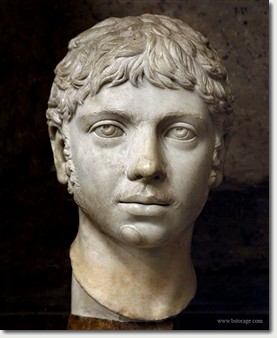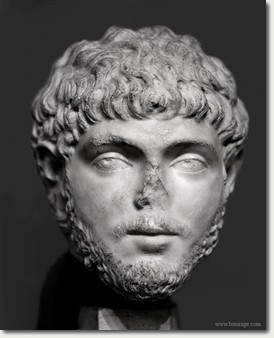| Imperial Portraits of Elagabalus |
Home Up to Imperial Portraiture
Preceded by Macrinus Succeeded by Severus Alexander Grandson of Julia Maesa |
|
| Photos by Bill Storage and Laura Maish Email us about this page |
||
| Elagabalus, also known as
Heliogabalus, was born Varius Avitus Bassus. His name as emperor (218 -
222) was Marcus Aurelius Antoninus. He was son of Julia Soaemias and
grandson of Julia Maesa, thus he was the cousin of Severus Alexander,
his successor. The portrait in photo 1 is generally accepted as that of Elagabalus. Museo Capitolino inv. MC470. The entire nose, part of the chin and part of the upper lip are restorations. The surface of the head has been altered by acid cleaning. Helga von Heintze argued for this being a posthumous portrait of Severus Alexander, displaying a form of circular reasoning that has unfortunately been all too common in studies of imperial art. Since virtually no extant portraits of the mid-3rd century have attached inscriptions, the most secure portrait identifications are based on coins. From the securely identified portraits, scholars reached conclusions about stylistic trends in the rendering of faces and hair. The trends were then dated, based on knowledge of the years in which the subject emperors reigned. The trends, once observed, though based on a scarcity of data points, are then observed (perhaps imagined, it seems) in portraits needing identification. These stylistic trends are then given a higher priority for identifying a subject than resemblance to coin portraits or anthropometric comparisons. Von Heintze seemed to ignore the fact that this being a posthumous portrait of Severus Alexander would require that Alexander's survivors chose to have him rendered as a teen-ager, a very odd choice for a man who died at age 27. Likewise she ignores the much closer resemblance between this and coin portraits of Elagabalus, and the differences in facial features and cranium shape between this and portraits accepted as portraying Alexander. More recently, Wiggers and Wegner (Herrscherbild III) do conclude that this is Elagabalus. The portrait in Photo 2, dated to the Severan period, has some similarities to that in photo 1, although the eyes are less abstractly rendered. Cranium shapes facial proportions are actually very similar, despite the illusion of a triangular face created by the facial hair in photo 2. |
| Copyright 2007 Bill Storage and Laura Maish. Created 2/8/2007 |
|

